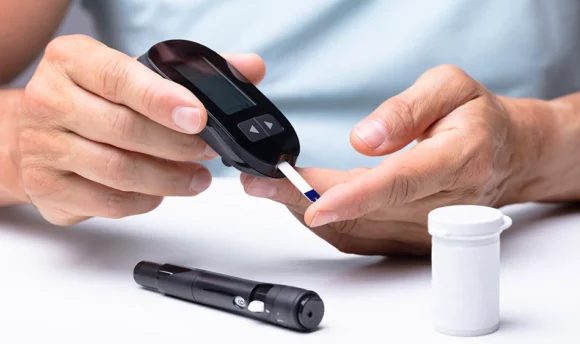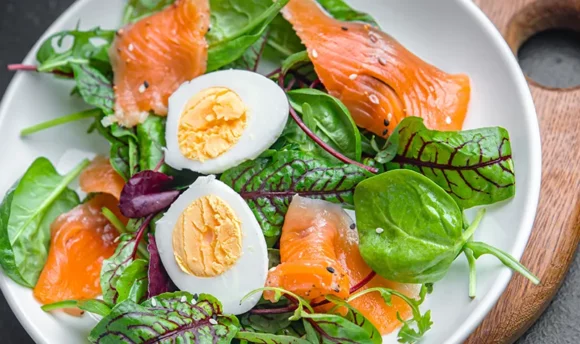Keto Diet: How Does It Work?
Here’s everything you need to know about the keto diet before starting.

If you’ve been looking into weight loss methods recently, you’ve probably come across a lot about the ketogenic diet. The keto diet is a popular dieting method that has proven efficacy for those wanting to lose weight, but how does it work?
The keto diet requires you to eat a low-carb, high-fat diet to move your body into the fat-burning metabolic state of ketosis. It also comes with a range of other health benefits.
If you’re wondering how adding more fat to your diet could possibly help you to lose weight and reduce your body fat percentage, then take a look at the rest of this article.
We’ll be taking a deep dive into the ketogenic diet, looking at how it works, what the health benefits of eating keto are, and how you can successfully use this dieting method for weight loss.
What Is the Keto Diet?
The keto diet is a high-fat, moderate-protein, low-carb diet that moves your body into the metabolic state of ketosis. In this state, the body burns stored fat for energy rather than blood sugar.
There are a few different versions of ketogenic diets, including clean keto, lazy keto, and the cyclical ketogenic diet, but they all follow the same principles of reducing your carbohydrate intake and increasing your fat intake to trigger ketosis.
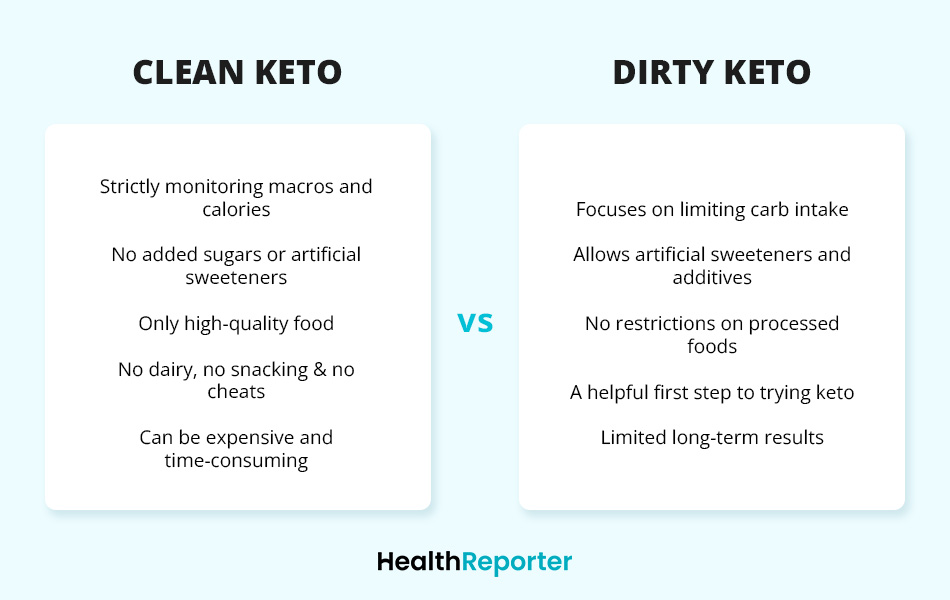
Though low-fat diets are usually claimed to be the only way to reduce overall body weight, the ketogenic diet taps into the body’s survival mechanisms and creates an environment in which the body burns fat to keep it going.
Reducing your carbohydrate intake removes the usual energy source (blood sugar) from your body, meaning you need another source of energy. In low-carb diets like the ketogenic diet, this energy source is fat.
What Is Ketosis, and How Does It Work?
Ketosis is a metabolic state triggered by low carb diets and reduced carbohydrate levels, where the body burns stored fat for fuel rather than blood sugar. It is a natural state and is commonly triggered during periods of fasting and as a defense mechanism during starvation.
Ketosis refers to a state when blood ketone levels are increased. Ketone levels increase when you reduce your carbohydrate consumption, usually through low-carb diets like the keto diet or the Atkins diet.
Though glucose is the preferred energy source in most cells, a drop in carb intake leads to a drop in blood sugar. This drop in blood sugar levels leads to a drop in the hormone insulin, which causes fatty acids that are stored in the body to be released into the blood.
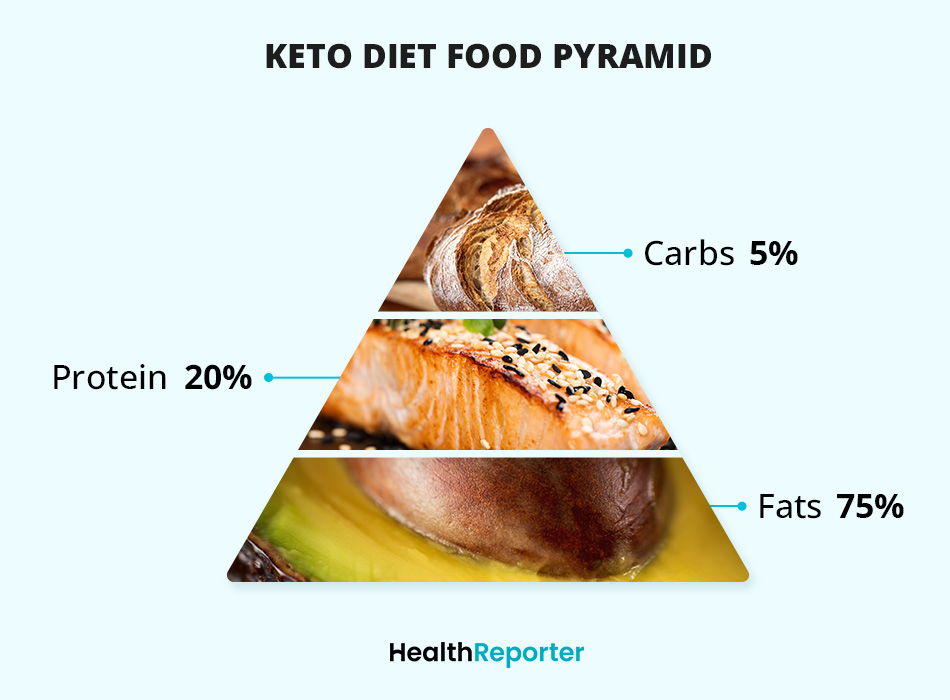
Fatty acids move through the body to the liver, which then turns them into ketone bodies. Ketone bodies are an alternative energy source and can be used to fuel your body. Unlike fatty acids, ketones can cross the blood-brain barrier.
Inducing this state in the body through low-carb, high-fat diets like the keto diet boosts weight loss by increasing the amount of fat that is burned by the body.
The Keto Flu: Symptoms and How to Get Rid of It
Keto flu refers to a number of symptoms that are generally experienced between 2–7 days after starting the ketogenic diet. Symptoms include headaches, foggy brain, nausea, difficulty sleeping, and constipation. The keto flu is not a recognized illness by medical professionals.
There is little research into what actually causes the keto flu, and some people may not experience it at all. Some attribute these symptoms to the body adjusting to a cleaner diet, while others believe it relates to the gut microbiome.
While we don’t really know what causes it, there are a few things you can do to reduce these symptoms and ease the transition into the ketogenic diet. These include:
- Drinking plenty of water to combat dehydration
- Avoiding any form of strenuous exercise
- Replacing electrolytes lost due to decreased insulin levels
- Getting adequate, quality sleep (for adults, this is at least 7 hours per night)
- Ensuring you eat enough fat to keep your body fuelled
- Eating enough carbohydrates, while still sticking to the recommended limit
Unlike the actual flu, you’re unlikely to be incapacitated by these symptoms. Treating your body kindly while it adjusts to the ketogenic diet is the best way to counteract these symptoms and stay on track with the keto diet.
How to Start the Keto Diet
Starting the keto diet can feel intimidating. A high-fat diet may seem counterintuitive to weight loss, and getting the ketogenic diet right is essential to seeing results. Below are a few steps you should take to start the ketogenic diet.
Find out what foods you can and can’t eat on the ketogenic diet
Knowing what you can eat and what you should avoid helps you to decide whether the ketogenic diet is viable for you. It can also help you to plan meals and create a shopping list.
Understand fat
After years of being told that low-fat diets were the best method of weight loss and that fat is bad, it can be confusing to suddenly be told that a high-fat diet can help you lose weight.
Newer medical research suggests that, unlike what we previously thought, not all fat is bad. Instead, it is about the type of fat we eat. Do some research into the difference between saturated fat and unsaturated fat to see how these different types affect your body. And break up with the idea that a low-fat diet is the only way to lose weight!
Take a look at some ketogenic diet-friendly recipes
If you’re not a fan of cooking, the ketogenic diet may be difficult for you. Unlike other diets, the ketogenic diet will require much more at-home prep to ensure you’re eating the right amounts of carbs, fats, and proteins. Can you follow a ketogenic diet if you are a vegetarian or vegan? For sure! There are plenty of recipes for vegetarian keto dieters and vegans on keto.
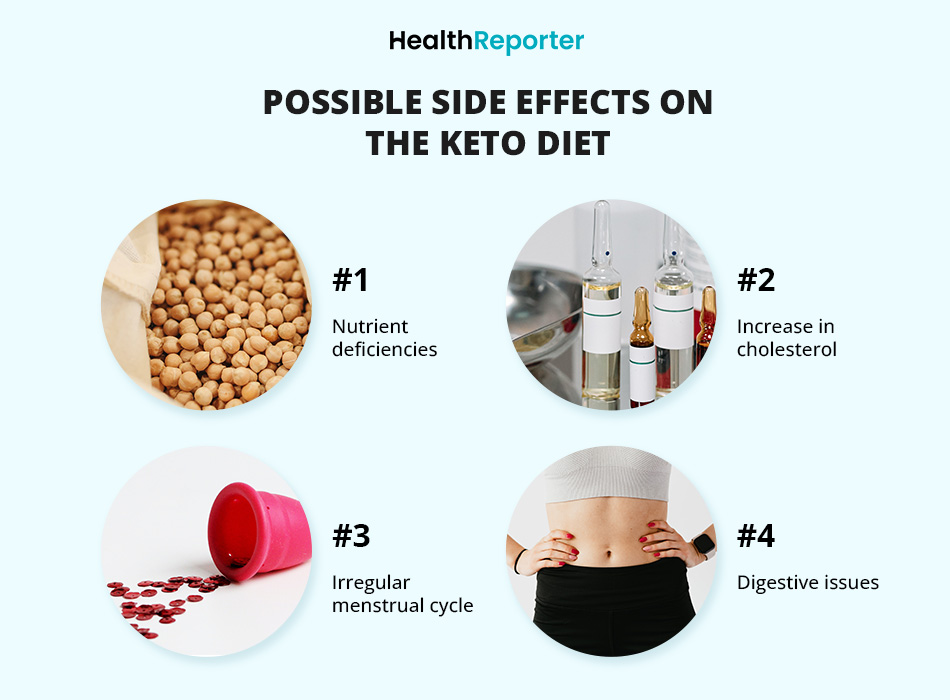
Understand the side effects
Unfortunately, the ketogenic diet will come with some side effects. While these will get better after your body has adjusted, be prepared for them so that you’re ready and able to deal with them while staying motivated in your weight loss goals.
Like any diet, starting the ketogenic diet requires you to really understand why you’re eating in this way and how it will affect your body when you do.
Benefits of the Ketogenic Diet
The ketogenic diet comes with a range of health benefits that include weight loss, among other health-boosting factors. Below, we’ve summarized a few of the key benefits of following one of the ketogenic diets.
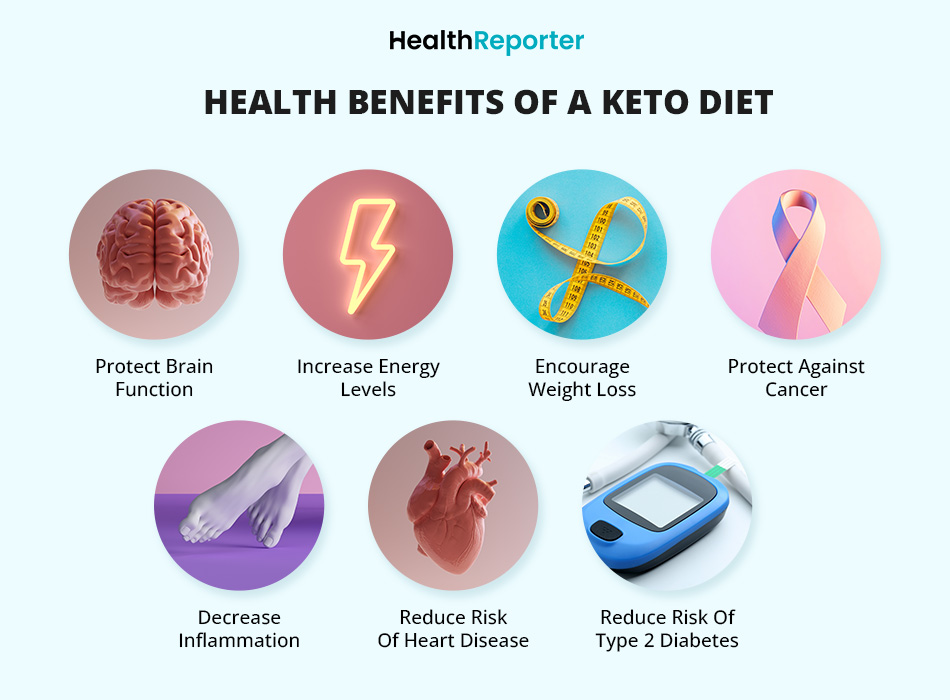
#1 Weight loss
Weight loss is the main reason most people choose to follow ketogenic diets. It has been proven an effective tool for weight loss.
The main benefit of low carbohydrate diets like ketogenic diets is that they trigger the metabolic switch to ketosis. This boosts your body’s fat metabolism, thereby reducing your body fat and, by extension, overall body weight.
The fat loss achieved by following a very low carbohydrate diet like the ketogenic diet can help to boost your overall health too. Carrying too much body fat can put you at increased risk of high blood pressure, type 2 diabetes, and cardiovascular disease, among other illnesses.
The ketogenic diet helps you to alter your body composition and reduce fat, boosting your health overall.
#2 Reduced blood sugar
Following a ketogenic diet may help to lower blood sugar levels and increase blood sugar control.
To begin with, the ketogenic diet boost weight loss and fat reduction. Reducing excess fat in your body can reduce your risks of developing type 2 diabetes and prediabetes. In addition, some studies suggest that the ketogenic diet can increase insulin sensitivity, supporting the management of sugar levels in the blood.
The keto diet is an effective tool for the management of type 2 diabetes too, and one study, in particular, showed evidence of better management of sugar levels in the blood in women with type 2 diabetes who followed a keto diet.
There is also some evidence that suggests this reduction in blood glucose levels, and therefore insulin levels may be beneficial for women and those who suffer from polycystic ovary syndrome.
#3 Stable energy levels
Eliminating carbohydrates from your diet is an effective method of stabilizing your energy levels. Each time you eat carbs at a meal, your blood glucose levels spike, which can increase your energy levels, but after this spike, your energy levels will then drop dramatically.
Many users of the keto diet have reported that their energy levels and brain function remain more consistent throughout the day while following ketogenic diets.
Though it may take some time for your body to adjust, you will soon feel the benefits of eating the keto way. Reducing your net carbs each day increases the ketones in your body. Ketones are a great fuel source, particularly for the brain, and can help you to feel more alert and energetic.
#4 Reduced inflammation
The keto diet is known for its ability to reduce inflammation in the body. While inflammation is a good thing in the body when in response to trauma, chronic inflammation can lead to a range of illnesses. The keto diet may help to reduce this.
In patients with rheumatoid arthritis, ketosis is thought to be a factor in reducing the inflammation that causes this disease. Research is limited, but some evidence suggests that the keto diet could help with the management of the symptoms of arthritis.
In addition, the ketones released into the blood during ketosis have been proven to reduce oxidative stress in the body and activate pathways that inhibit inflammatory pathways in the body.
Both chronic inflammation and oxidative stress can be linked to the development of Alzheimer’s disease and other neurodegenerative conditions. The keto diet is thought to reduce the symptoms and slow the progression of Alzheimer’s disease.
The keto diet is also high in many anti-inflammatory foods. Anti-inflammatory foods include olive oil, coconut oil, eggs, avocados, low-carb veggies like cauliflower, leafy greens like kale, spinach, and collard greens, and fatty fish.
There is some evidence to suggest that a keto diet that is too high in saturated fat could make some inflammatory diseases worse, but the evidence is limited.
#5 Better cognitive performance
The ketogenic diet may improve cognitive performance and mental clarity. Self-reported accounts attest to an increase in brain function and feelings of alertness while following the keto diet, and some scientific evidence supports these claims.
Keto diets increase your blood ketone levels which are thought to improve mental clarity and cognitive performance. Additionally, a very low-carbohydrate diet stabilizes blood glucose levels which may help with brain function too.
Possible Side Effects of the Keto Diet
As with any weight loss diet, the ketogenic diet does come with some possible side effects. We’ve summarized each of these below.
#1 Nutrient deficiencies
Reducing your net carbs may lead to nutrient deficiencies due to the reduced intake of fruits and vegetables. Many nutrient-rich fruits, vegetables, and legumes are not keto-friendly due to their high net carbs value, but by cutting them out, you also cut out the many micronutrients they offer.
Those on keto for a longer time might even notice hair loss: this is a common symptom of malnutrition.
On the keto diet, it is important to still reach your micronutrient intake level too to avoid becoming nutrient deficient. You could try keto-friendly nutrient-rich foods or keto-friendly supplements.
#2 Increase in cholesterol
While on the keto diet, there is a risk of an increase in cholesterol levels. This makes the diet unsafe for those who have a history of high cholesterol levels or suffer from kidney disease or liver disease.
Though there is an initial increase in LDL cholesterol levels (the bad kind of cholesterol), some research suggests that this increase is only temporary and that levels eventually even out.
If you know you have high cholesterol levels or are at risk of having them, speak with your doctor or healthcare provider about the risks involved with the ketogenic diet and your cholesterol levels before trying it out.
#3 Irregular menstrual cycle
Following a low-carb diet has been linked to menstrual cycle disruption. The reasons for this can be attributed to a number of different factors.
To begin with, low-calorie intake and low-carb diets can affect the function of the adrenal glands in those who menstruate. These glands are sensitive to everything from stress to caloric intake and work to keep your hormones in balance. Unbalanced hormones may lead to disruption in the menstrual cycle.
You may also experience what is known as amenorrhea which is defined by the absence of the menstrual cycle for three months or more. Many factors, including consuming too few carbs and calories, can lead to amenorrhea.
In addition, leptin, a hormone produced by fat cells, may be suppressed by a low-calorie diet or reduced carbohydrate intake. Research has shown that those who menstruate need certain levels of leptin for proper menstrual function.
#4 Digestive issues
Though the keto diet could benefit some with digestive conditions, like IBS, other people may experience digestive issues when trying out this diet.
The ketogenic diet eliminates a number of high-fiber foods. Fiber is an essential part of the digestive system and supports its proper functioning. By removing high-carb, starchy vegetables while on the keto diet, you also decrease your fiber intake, which could lead to digestive issues.
There is also some evidence that suggests the ketogenic diet can alter the gut microbiome. This could lead to digestive issues in some but can be managed with the introduction of pre and probiotics into the diet.
Ketogenic Diet for Diabetes and Prediabetes – Is It Effective?
The ketogenic diet is an effective tool for those with prediabetes and type 2 diabetes to manage their symptoms and reduce their frequency.
To begin with, the ketogenic diet causes significant fat loss. Excess fat is associated with an increased risk of developing prediabetes and type 2 diabetes. Reducing excess fat could reduce your risk of developing these conditions.
The keto diet is thought to increase your sensitivity to insulin. A reduction in insulin sensitivity is characteristic of those at risk of prediabetes and type 2 diabetes. Improved insulin sensitivity helps you gain back control over blood glucose levels.
Many studies have shown that the keto diet provides improved management of blood glucose levels in patients with type 2 diabetes.
Trying out the ketogenic diet may help to manage your symptoms of diabetes. Speak with your healthcare provider to see if the keto diet is a viable option for your condition.
It is recommended that those with type 1 diabetes seek medical advice before trying the ketogenic diet due to the extra risks involved.
Foods to Eat on the Keto Diet

Many people think that the ketogenic diet is restrictive, but there are actually tons of foods you can eat while on it. Below is a list of some keto-friendly foods:
- Meat, including chicken, turkey, and red meat in limited amounts
- Fatty fish, like tuna, mackerel, and salmon
- Eggs
- Butter, cream, and cheeses
- Nuts and seeds
- Healthy oils, like olive oil and avocado oil
- Avocados
- Low-carb vegetables
- Some condiments, like guacamole and mayonnaise
Foods to Avoid on Keto
Along with all the foods you can eat on a keto diet are some foods you should totally avoid. Below is a list of foods you cannot eat when you’re following the ketogenic diet.
- Foods that are high in sugar, including candies, chocolate, baked goods, sweeteners, such as molasses etc.
- Grains and starches, like pasta and rice
- Fruit, with the exception of some small portions of berries
- Beans and legumes
- Root vegetables, tubers, and starchy veg, including potatoes, sweet potatoes, and some squash varieties
- Low-fat, reduced-fat, or diet products
- Unhealthy fatty foods, like those high in saturated fats, processed meats, etc.
- Alcohol, especially sugary drinks, such as eggnog
Best Keto Snacks
When it comes to a new diet, you’re probably going to want to know what kind of snacks you’re allowed. We’ve rounded up some of the best keto snacks below for you to peruse.
- Nuts, like brazil nuts, pecans, and macadamia nuts
- Hard-boiled egg
- Avocado
- Bone broth
- Fermented veg
- Olives
- Dark chocolate (in moderation!)
FAQs
The keto diet is a safe diet for most people to follow. Some groups of people should not follow it, including those who are pregnant or breastfeeding, those with kidney or liver disease, and those with a history of disordered eating.
The ketogenic diet is a very good method of weight loss. It triggers the metabolic state of ketosis, which helps you reduce fat and aids in overall weight reduction. This weight loss may also improve other health aspects, including reducing high blood pressure and the risk of developing heart disease.
Generally, keto dieters should stick to a carbohydrate limit of no more than 50 g per day. This figure varies depending on where you get your information, though, so you should work out the carb intake that works best for you.
Lazy keto is a keto method wherein less tracking and calculating is involved. Though you still stick to a reduced carb, high-fat diet composition, you would eat around 20g of carbs a day and then loosely prioritize fat and protein in your diet to induce ketosis.
The diet doesn’t focus on food quality as a cleaner keto diet does, and it can lead to eating too many carbs without realizing it.
There are a number of signs that you are in ketosis. These include increased focus and energy, appetite impression, fruity-smelling breath, increased ketones in the blood, insomnia, and short-term reduction in physical performance.
Your urine may smell fruity while on the keto diet due to the increased presence of ketones in it. Ketones give off a fruity smell which can affect the urine and the breath in keto dieters. It is not something to worry about.
Apart from water, you may also enjoy plenty of other keto-friendly drinks, such as unsweetened tea, black coffee, almond milk, etc.
A Word From Our Nutritionist
The ketogenic diet is an effective method of weight loss. It triggers the metabolic switch to ketosis, wherein the body burns fat for energy over blood glucose. This leads to a reduction in body fat and overall body weight.
To eat the keto way, you need to reduce your overall intake of carbs and increase your intake of dietary fat. The ketogenic diet is used by many people around the world to reduce their weight and improve their overall health.
The keto diet comes with a range of benefits, including reducing blood pressure, blood glucose levels, and LDL cholesterol levels and reducing your risk of a range of chronic illnesses, including type 2 diabetes and heart disease.
The ketogenic diet can be part of a healthy lifestyle for many, but it comes with some dietary restrictions that should be taken into account before you try it out. Ensure you do some research to decide whether the diet is a viable option for you before starting it out.
Though the keto diet does work for many, there are some who should not try it, including those on certain medications, those who are pregnant or breastfeeding, and those who have a history of eating disorders.
Be aware that the keto diet may not work for you as a method of weight loss. If you try it and find it does not work for you, then there are other effective methods of weight loss, including intermittent fasting and eating at a calorie deficit which you could try.
Conclusion
The ketogenic diet involves limiting the carbohydrates you eat each day and increasing your fat intake. The diet aims to induce the state of ketosis, where the body burns fat for energy over blood glucose.
The keto diet is considered a safe method of weight loss and is accessible to most, provided they are willing to put the time and effort into understanding the diet and how to do it properly.

















































 Select your language:
Select your language: 







